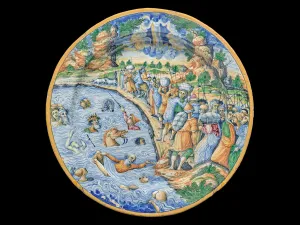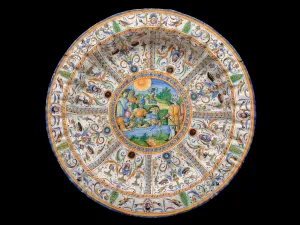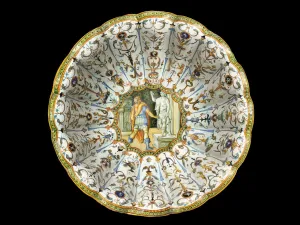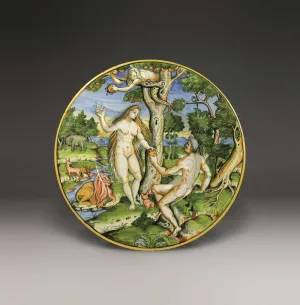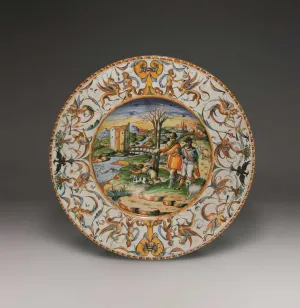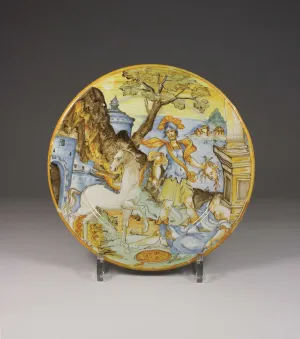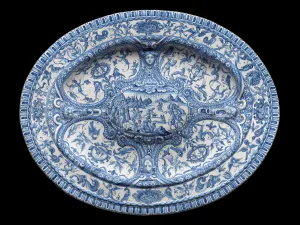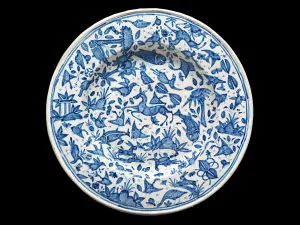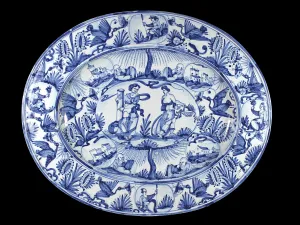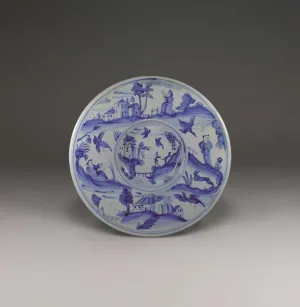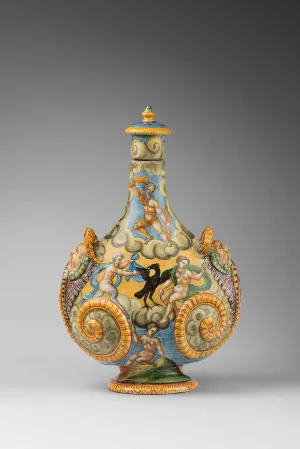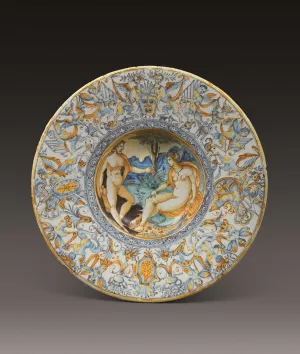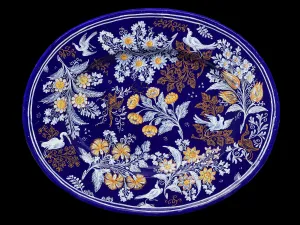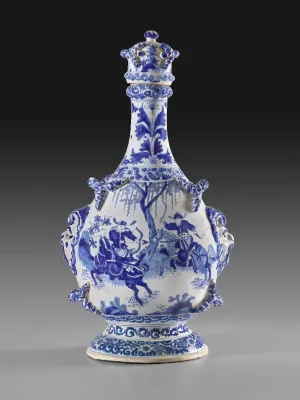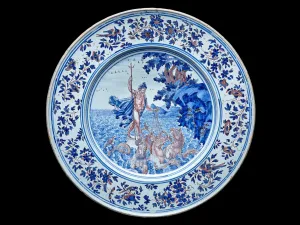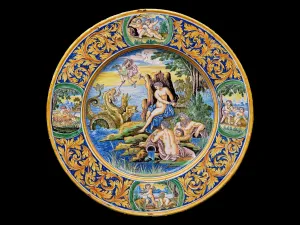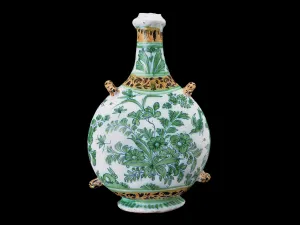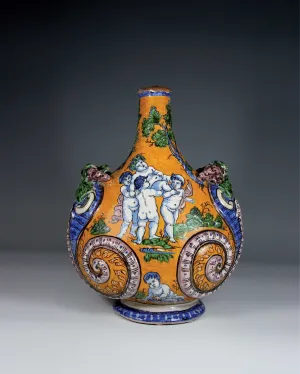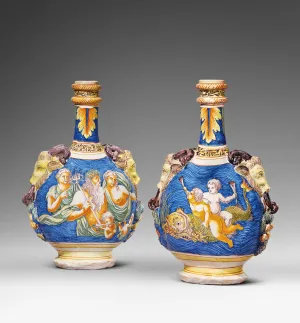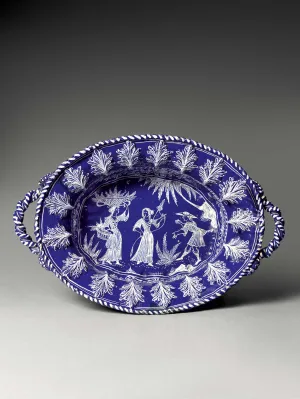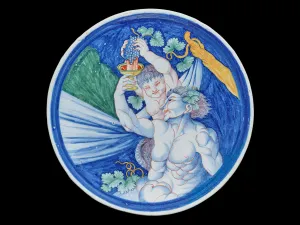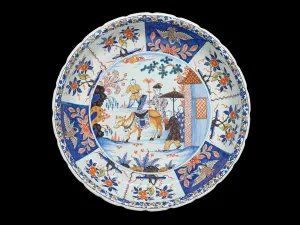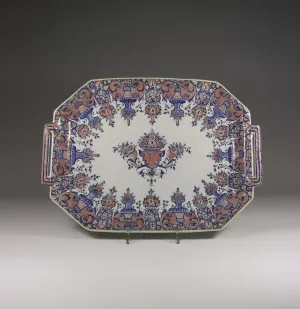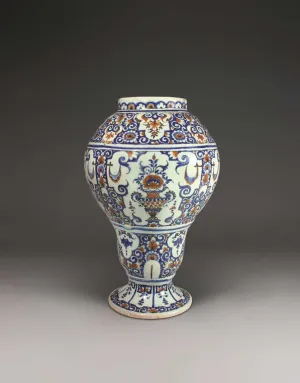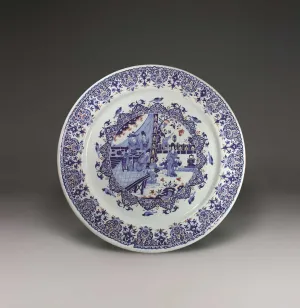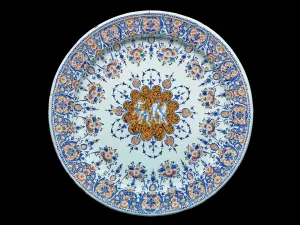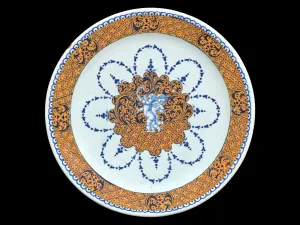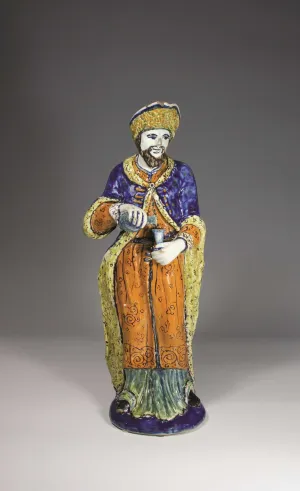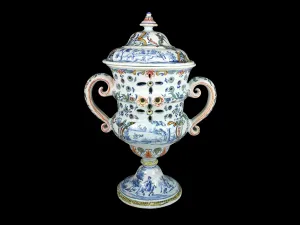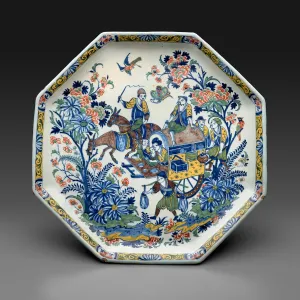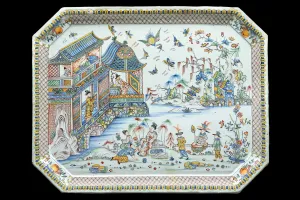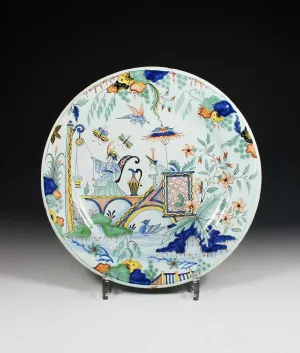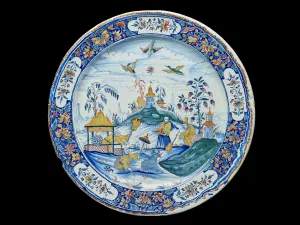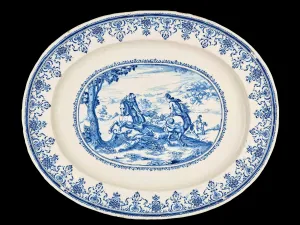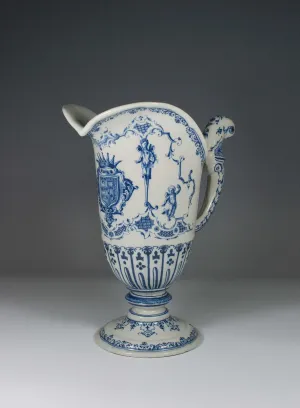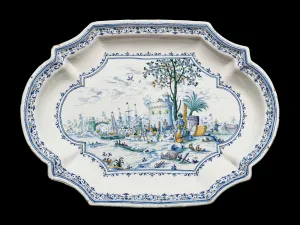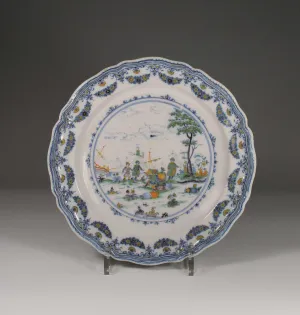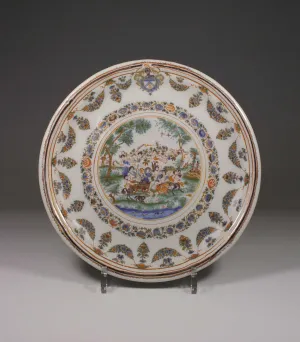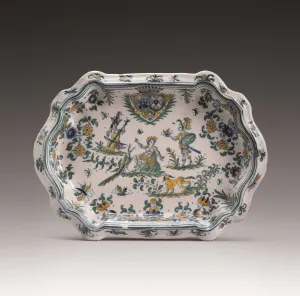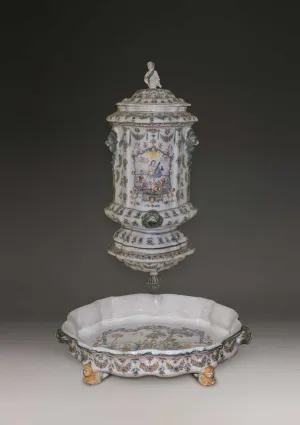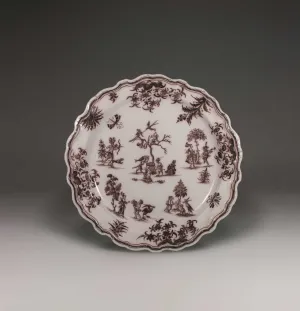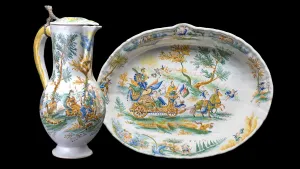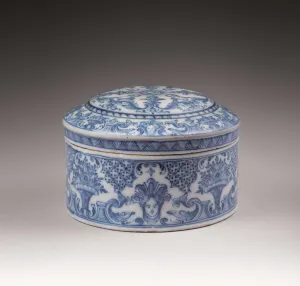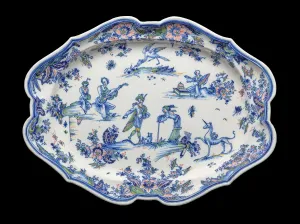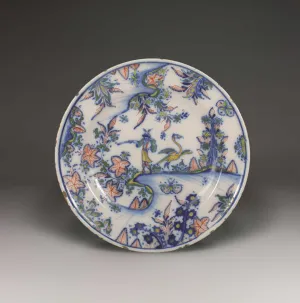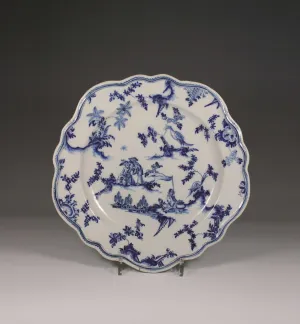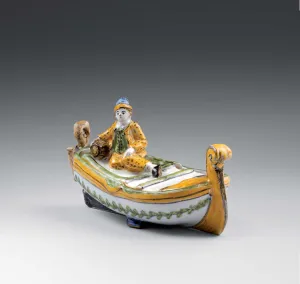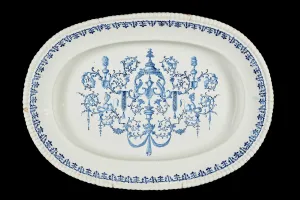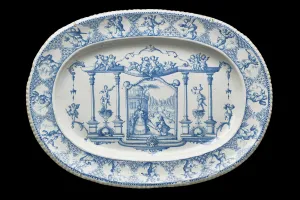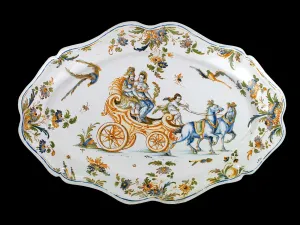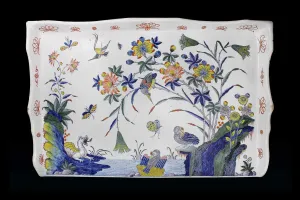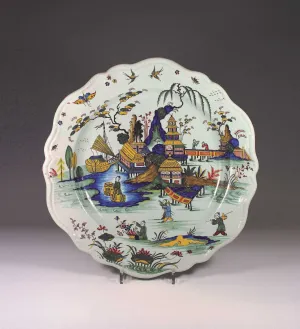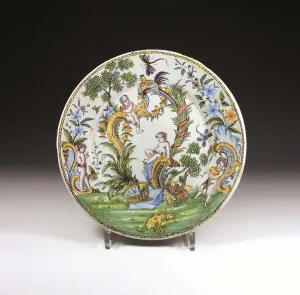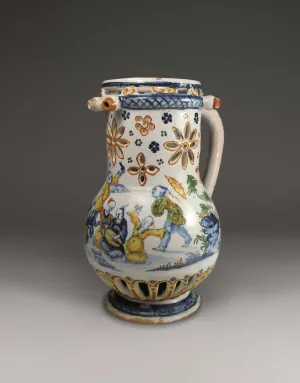Checklist
Plate
Urbino, ca. 1560, or Lyon, ca. 1582−85
If Lyon, painting attributed to Gironimo Tomasi
Faience (tin-glazed earthenware)
Diam. 16 1/8 in. (41 cm)
Inscription: on the reverse, Mose riprende il popolo e l’eforta! [Moses reprimands the people and exhorts them]
Cat. 1
© Christophe Perlès
Plate
Lyon, ca. 1582−85
Painting attributed to Gironimo Tomasi
Faience (tin-glazed earthenware)
Diam. 17 3/4 in. (45 cm)
Inscription: on the reverse, In columna nubis / israelitas Deus / proecedit / EXOD / XIII [In a pillar of cloud, God leads the Israelites / EXODUS/ XIII]
Cat. 2
© The Frick Collection
Dish
Lyon, ca. 1582−1600
Painting attributed to Gironimo Tomasi
Faience (tin-glazed earthenware)
Diam. 18 7/8 in. (48 cm)
Inscription: on the reverse, Giedeô Selegit cô tra / madian / IVD. IIIII [Gideon has chosen [in the fight] against Midian / IVD IIIII]
Cat. 3
© The Frick Collection
Fluted Bowl
Lyon, ca. 1582−1600
Painting attributed to Gironimo Tomasi
Faience (tin-glazed earthenware)
H. 5 3/8 in. (13.6 cm), diam. 14 1/2 in. (36.9 cm)
Cat. 4
© Beylard, Ferrier and Lewandowski
Plate
Lyon, ca. 1580−1610
Faience (tin-glazed earthenware)
Diam. 10 7/8 in. (27.5 cm)
Inscription: on the reverse, GENESE.III / Adam et Eve [GENESIS. III / Adam and Eve]
Cat. 5
© Christophe Perlès
Platter
Urbino or Lyon, ca. 1600
If Urbino, attributed to the Patanazzi workshop
Faience (tin-glazed earthenware)
Diam. 18 1/2 in. (47 cm)
Cat. 6
© Christophe Perlès
Plate
Nevers, 1635
Attributed to Denis Lefebvre
Faience (tin-glazed earthenware)
Diam. 8 1/2 in. (21.5 cm)
Inscription: on the reverse, PerSee Et Meduse / 1635 [Perseus and Medusa / 1635]
Cat. 7
© Christophe Perlès
Dish
Nevers, ca. 1630−50
Attributed to the workshop of Antoine Conrade
Faience (tin-glazed earthenware)
H. 19 1/2 in. (42 cm), W. 24 3/4 in. (63 cm)
Cat. 8
© The Frick Collection
Pair of Covered Vases
Nevers, ca. 1640
Attributed to the workshop of Antoine Conrade
Faience (tin-glazed earthenware)
H. 12 3/8 in. (31.5 cm), W. 7 in. (17.8 cm)
Cat. 12
© Christophe Perlès
Plate
Nevers, ca. 1645
Workshop of Antoine Conrade
Faience (tin-glazed earthenware)
Diam. 18 1/8 in. (46 cm)
Inscription: on the reverse, fait a nevers chez Mr di Conradi [made at Nevers in Mr di Conradi’s workshop]
Cat. 13
© The Frick Collection
Plate
Nevers, ca. 1645
Workshop of Antoine Conrade
Faience (tin-glazed earthenware)
H. 16 in. (40.6 cm), W. 19 7/8 in. (50.6 cm)
Inscription: on the reverse, de Conradi A Nevers [by Conrade in Nevers]
Cat. 14
© Christophe Perlès
Dish
Nevers, ca. 1640−50
Attributed to the workshop of Antoine Conrade
Faience (tin-glazed earthenware)
Diam. 11 1/2 in. (29.3 cm)
Cat. 15
© Christophe Perlès
Gourd
Nevers, ca. 1640
Attributed to the workshop of Antoine Conrade
Faience (tin-glazed earthenware)
H. 17 1/2 in. (44.3 cm), W. 11 in. (28 cm)
Cat. 9
© Beylard, Ferrier and Lewandowski
This gourd demonstrates the lasting influence of Italian models on the Nevers production, as well as the popularity in France of ceramics made in Italy seventy years earlier. It is decorated with a colorful istoriato representing Jupiter transformed into a satyr and approaching Antiope (on the front) and two satyrs (on the back). Its distinctive shape with two handles in the form of grotesque heads also followed Renaissance Italian maiolica produced in Urbino about 1560.
Plate (tondino)
Nevers, ca. 1640
Attributed to the workshop of Antoine Conrade
Faience (tin-glazed earthenware)
Diam. 11 1/4 in. (28.7 cm)
Cat. 10
© Beylard, Ferrier and Lewandowski
Related to cat. 11
Plate (tondino)
Nevers, ca. 1640
Attributed to the workshop of Antoine Conrade
Faience (tin-glazed earthenware)
Diam. 11 3/8 in. (29 cm)
Cat. 11
© Beylard, Ferrier and Lewandowski
Related to cat. 10
On this plate, the allegory of a river is depicted as a bearded man. Decorating the center of the other plate is a different allegory of a river with a naked woman leaning on an amphora from which water is flowing, and sitting opposite her, a naked man, possibly representing Earth. Both scenes are surrounded by colorful satyrs, winged figures, horses, and trophies, all painted on a white ground.
Platter
Nevers, ca. 1660−70
Faience (tin-glazed earthenware)
H. 16 in. (40.7 cm), W. 19 3/4 in. (50 cm)
Cat. 16
© The Frick Collection
By the middle of the seventeenth century, Nevers potters and painters were exploring new types of decoration, probably with the hope of forging a new artistic identity and attracting a broader clientele, while also responding to the artistic revolution taking place in France under Louis XIV (r. 1643–1715). Italian potters had, by this time, been established in France for several generations, and some French potters had no Italian roots at all; the Italian influence had therefore become weaker.
Gourd
Nevers, ca. 1670−80
Faience (tin-glazed earthenware)
H. 17 3/8 in. (44 cm), W. 9 in. (23 cm)
Cat. 17
© The Frick Collection
Plate
Nevers, ca. 1680−85
Faience (tin-glazed earthenware)
Diam. 22 3/8 in. (56.8 cm)
Cat. 21
© The Frick Collection
Plate
Nevers, ca. 1680−90
Faience (tin-glazed earthenware)
Diam. 22 1/8 in. (56.2 cm)
Cat. 22
© The Frick Collection
Flask
Nevers, ca. 1680−90
Faience (tin-glazed earthenware)
H. 11 in. (28 cm), W. 7 in. (17.8 cm)
Cat. 23
© The Frick Collection
Gourd
Nevers, ca. 1680−90
Faience (tin-glazed earthenware)
H. 14 5/8 in. (37 cm), W. 11 in. (28 cm)
Cat. 24
© Christophe Perlès
Plate
Nevers, ca. 1680−90
Faience (tin-glazed earthenware)
Diam. 9 1/4 in. (23.5 cm)
Cat. 25
© Christophe Perlès
Dish
Nevers, ca. 1680−1700
Faience (tin-glazed earthenware)
Diam. 18 3/4 in. (47.7 cm)
Cat. 26
© Christophe Perlès
Pair of Flasks
Nevers, ca. 1680−1700
Faience (tin-glazed earthenware)
H. 13 1/8 in. (33.4 cm), W. 8 1/2 in. (22 cm)
Cat. 27
© Christie's
Orange-Tree Planter
Nevers, ca. 1680
Faience (tin-glazed earthenware)
H. 25 in. (63.5 cm), W. 27 in. (68.6 cm), D. 21 1/8 in (54 cm)
Cat. 20
© Christophe Perlès
Over the years, Nevers potters and painters refined the technique of tin-glazed earthenware, which enabled them to produce larger and more ambitious objects, like this rare tree planter, the largest faience piece known today. Its general shape was influenced by contemporary architecture, and the two large heads of Apollo on each side are characteristic of the Baroque style developed at the court of Versailles under Louis XIV.
Ewer
Possibly forming a set with Basin
Nevers, ca. 1680
Faience (tin-glazed earthenware)
H. 27 1/2 in. (70 cm), W. 13 in. (33 cm)
Cat. 18
© Christophe Perlès
This ewer and the recently discovered basin are the most beautiful known pieces made with the famous dark blue background known as “Nevers blue,” invented in the second half of the seventeenth century in Nevers. Their shapes recall silver pieces used at the court of Louis XIV while their painted decoration — with figures wearing turbans, a shepherdess spinning a distaff, and peddlers — is inspired by early seventeenth-century French literature, including the novel L’Astrée by Honoré d’Urfé, published between 1607 and 1627.
Basin
Possibly forming a set with Ewer
Nevers, ca. 1680
Faience (tin-glazed earthenware)
H. 19 1/4 in. (49 cm), L. 22 3/4 in. (58 cm)
Cat. 19
© Camille Leprince
This recently discovered basin and the ewer are the most beautiful known pieces made with the famous dark blue background known as “Nevers blue,” invented in the second half of the seventeenth century in Nevers. Their shapes recall silver pieces used at the court of Louis XIV while their painted decoration — with figures wearing turbans, a shepherdess spinning a distaff, and peddlers — is inspired by early seventeenth-century French literature, including the novel L’Astrée by Honoré d’Urfé, published between 1607 and 1627.
Dish
Rouen, ca. 1725−30
Painted by Pierre II Chapelle
Faience (tin-glazed earthenware)
Diam. 12 in. (30.4 cm)
Cat. 37
© The Frick Collection
Because so few faience painters signed their pieces, attributions to a specific artist are almost impossible. One exception is Pierre II Chapelle (1695−1730), whose father was also an important faience painter in Rouen. Pierre II Chapelle signed a few pieces painted in a distinctive, virtuosic style after contemporary French engravings.
Dish
Rouen, ca. 1730−40
Faience (tin-glazed earthenware)
Diam. 13 in. (33 cm)
Cat. 41
© The Frick Collection
As elsewhere in Europe, the import of Japanese lacquers, textiles, and porcelain left an important mark on potters in Rouen. This dish is influenced by Japanese Imari porcelain, characterized by extensive floral motifs painted in radiant blue and iron-red, and gold, although the central scene likely derives from a Chinese model.
Tray
Rouen, ca. 1740−50
Faience (tin-glazed earthenware)
H. 17 7/8 in. (45.5 cm), W. 20 1/4 (51.4 cm)
Cat. 45
© The Frick Collection
The quality of the painting and the varied types of decoration that developed in Rouen during the first half of the eighteenth century are further exemplified by this tray featuring a peasant scene in the manner of the seventeenth-century Flemish painter David Teniers the Younger.
Tray
Rouen, ca. 1700−20
Faience (tin-glazed earthenware)
H. 12 1/2 in. (31.8 cm), W. 17 7/8 in. (45.3 cm)
Cat. 28
© Christophe Perlès
Pair of Vases
Rouen, ca. 1710−20
Faience (tin-glazed earthenware)
H. 11 1/4 in. (28.5 cm), W. 9 3/4 in. (25 cm)
Cat. 29
© The Frick Collection
Vase
Rouen, ca. 1710−20
Faience (tin-glazed earthenware)
H. 7 7/8 in. (20 cm), W. 5 in. (12.7 cm)
Cat. 30
© Christophe Perlès
Platter
Faience (tin-glazed earthenware)
Rouen, ca. 1710−20
Diam. 21 1/4 in. (54 cm)
Cat. 31
© Christophe Perlès
Platter
Rouen, ca. 1725
Faience (tin-glazed earthenware)
Diam. 21 1/4 in. (54 cm)
Cat. 32
© Christophe Perlès
Platter
Rouen, ca. 1725
Faience (tin-glazed earthenware)
Diam. 21 5/8 in. (55 cm)
Cat. 33
© The Frick Collection
Plate
Rouen, ca. 1725
Faience (tin-glazed earthenware)
Diam. 9 5/8 in. (24.5 cm)
Cat. 34
© The Frick Collection
Covered Vase
Rouen, ca. 1725
Faience (tin-glazed earthenware)
H. 12 in. (31.5 cm), W. 9 1/2 in. (24 cm)
Cat. 35
© Christophe Perlès
Plate with Coat-of-Arms of the Marquis de Saint-Evremont
Rouen, ca. 1725
Faience (tin-glazed earthenware)
Diam. 9 1/2 in. (24 cm)
Cat. 36
© The Frick Collection
Anthropomorphic Pitcher
Rouen, ca. 1730
Faience (tin-glazed earthenware)
H. 15 7/8 in. (40.3 cm), W. 6 in. (15.2 cm)
Cat. 38
© Christophe Perlès
Wall Bracket
Rouen, ca. 1740−50
Faience (tin-glazed earthenware)
H. 12 1/2 in. (32 cm), W. 12 in. (30.5 cm)
Cat. 46
© Christophe Perlès
This bracket is one of the most accomplished pieces made in Rouen in the exuberant rocaille style fashionable in France about 1730–50. The style was inspired by nature, especially shells, and the composition was typically asymmetrical. The central scene here depicts the beginning of a famous licentious tale by Jean de la Fontaine (1621−95) in which a flighty husband seduces a pretty serving girl as she is gathering flowers in his garden, while a neighbor observes the scene from her window.
Covered Puzzle Vase
Rouen, ca. 1740
Faience (tin-glazed earthenware)
H. 12 in. (30.5 cm), W. 7 1/4 in. (18.4 cm)
Cat. 44
© Christophe Perlès
A puzzle jug — with its typical perforated neck here in the shape of flowers — was technically challenging to make as it was designed so as not to spill its contents through the holes. This covered example is particularly charming, with a surprise rooster placed inside.
Tazza
Rouen, ca. 1730
Faience (tin-glazed earthenware)
H. 6 1/4 in. (15.8 cm), diam. 11 5/8 in. (29.5 cm)
Cat. 39
© The Frick Collection
Tray
Rouen, ca. 1730−40
Faience (tin-glazed earthenware)
H. 18 in. (46 cm), W. 22 3/4 in. (58 cm)
Cat. 40
© The Frick Collection
Plate
Rouen, ca. 1730−40
Faience (tin-glazed earthenware)
Diam. 9 3/4 in. (24.6 cm)
Cat. 42
© Christophe Perlès
Platter
Rouen, 1738
Faience (tin-glazed earthenware)
Diam. 22 1/2 in. (57 cm)
Marks: on the reverse, 1738
Cat. 43
© The Frick Collection
Platter
Moustiers, ca. 1700−20
Clérissy manufactory
Faience (tin-glazed earthenware)
H. 20 in. (50.8 cm), W. 24 3/4 in. (63 cm)
Cat. 49
© Christophe Perlès
Ewer
Moustiers, ca. 1700−25
Clérissy manufactory
Faience (tin-glazed earthenware)
H. 10 3/8 in. (26.5 cm), W. 9 1/2 (24.1 cm)
Cat. 50
© Christophe Perlès
Platter
Moustiers, ca. 1730−40
Clérissy manufactory
Faience (tin-glazed earthenware)
H. 12 1/4 in. (31.1 cm), W. 16 7/8 in. (43 cm)
Cat. 51
© The Frick Collection
Plate
Moustiers, ca. 1730−40
Clérissy manufactory
Faience (tin-glazed earthenware)
Diam. 9 7/8 in. (25.2 cm)
Cat. 52
© Christophe Perlès
Bowl on Foot
Moustiers, ca. 1740
Clérissy manufactory
Faience (tin-glazed earthenware)
Diam. 10 3/4 in. (27.3 cm)
Cat. 53
© Christophe Perlès
Tray with Coat-of-Arms of the Deschamps and Constant Families
Moustiers, ca. 1750
Clérissy manufactory
Faience (tin-glazed earthenware)
H. 7 in. (17.8 cm), W. 9 5/8 in. (24.5 cm)
Cat. 54
© Beylard, Ferrier and Lewandowski
Wall Fountain with Basin
Moustiers, ca. 1750
Olérys and Laugier manufactory
Faience (tin-glazed earthenware)
Fountain H. 27 in. (69 cm), W. 10 in. (25.4 cm); Basin W. 19 1/2 in. (50 cm), D. 13 1/2 in. (34.3 cm)
Marks: on the reverse, interlaced, S.OL
Cat. 55
© Christophe Perlès
Platter
Moustiers, ca. 1750
Olérys and Laugier manufactory
Faience (tin-glazed earthenware)
H. 13 in. (33 cm), W. 18 7/8 in. (48 cm)
Marks: on the reverse, interlaced, S.OL
Cat. 56
© Christophe Perlès
Plate
Moustiers, ca. 1750
Olérys and Laugier manufactory
Faience (tin-glazed earthenware)
Diam. 13 1/2 in. (34.3 cm)
Marks: on the reverse, interlaced, OL
Cat. 57
© Christophe Perlès
Sugar Caster
Moustiers, ca. 1750
Olérys and Laugier manufactory
Faience (tin-glazed earthenware)
H. 9 7/8 in. (25 cm), W. 3 3/4 in. (9.5 cm)
Cat. 58
© The Frick Collection
Platter
Moustiers, ca. 1750
Olérys and Laugier manufactory
Faience (tin-glazed earthenware)
H. 10 1/2 in. (26.7 cm), W. 14 7/8 in. (37.7 cm)
Marks: on the reverse, interlaced, OL, SC, and F
Cat. 59
© Christophe Perlès
Covered Pitcher and Basin
Moustiers, ca. 1760
Féraud manufactory
Faience (tin-glazed earthenware)
Basin H. 11 in. (23 cm), W. 14 in. (36 cm)
Pitcher H. 9 3/4 in. (25 cm), W. 7 in. (17.8 cm)
Cat. 60
© The Frick Collection
Powder Box
Attributed to Marseille, ca. 1720−30
Faience (tin-glazed earthenware)
H. 4 in. (10.2 cm), Diam. 6 in. (15.2 cm)
Cat. 61
© Beylard, Ferrier and Lewandowski
Fruit Dish
Marseille, ca. 1720
Leroy manufactory
Faience (tin-glazed earthenware)
Diam. 8 3/8 in. (21.2 cm)
Cat. 62
© Christophe Perlès
Platter
Marseille, ca. 1720−30
Leroy manufactory
Faience (tin-glazed earthenware)
H. 13 in. (33 cm), W. 17 3/8 in. (44 cm)
Cat. 63
© The Frick Collection
Plate
Marseille, ca. 1725−30
Leroy manufactory
Faience (tin-glazed earthenware)
Diam. 9 5/6 in. (24.5 cm)
Cat. 64
© Christophe Perlès
Plate
Marseille, ca. 1725−30
Attributed to the Leroy manufactory
Faience (tin-glazed earthenware)
Diam. 9 in. (23 cm)
Cat. 65
© Christophe Perlès
Platter
Marseille or Moustiers, ca. 1730
If Marseille, attributed to the Leroy manufactory
Faience (tin-glazed earthenware)
Diam. 13 3/8 in. (34 cm)
Cat. 66
© Christophe Perlès
Platter
Marseille, ca. 1730−40
Fauchier manufactory
Faience (tin-glazed earthenware)
H. 12 in. (30.5 cm), W. 16 in. (41 cm)
Cat. 67
© The Frick Collection
Boat-Shaped Spice Box
Attributed to Marseille, ca. 1750
Faience (tin-glazed earthenware)
H. 3 3/4 in. (9.5 cm), L. 6 1/4 in. (16 cm)
Marks: on the reverse, on either sides of the rudder, I and P
Cat. 68
© Beylard, Ferrier and Lewandowski
Dish
Montpellier, ca. 1730
Faience (tin-glazed earthenware)
H. 16 1/2 in. (42 cm), W. 23 3/4 in. (60.4 cm)
Cat. 48
© Christophe Perlès
Platter
Montpellier, ca. 1730
Faience (tin-glazed earthenware)
H. 16 1/2 in. (42 cm), W. 21 in. (53.5 cm)
Cat. 47
© Christophe Perlès
Platter
Lyon, ca. 1750−72
Attributed to the de la Borne Feuillée (The Leafy Bollard) manufactory
Faience (tin-glazed earthenware)
H. 12 in. (30.5 cm), W. 17 1/8 in. (43.5 cm)
Cat. 72
© Christophe Perlès
Platter
Lyon, ca. 1740−50
Attributed to the P. Mongis manufactory
Faience (tin-glazed earthenware)
H. 11 in. (28 cm), W. 15 1/8 in. (38.5 cm)
Cat. 71
© Christophe Perlès
Tray
Sinceny, ca. 1740−50
Faience (tin-glazed earthenware)
H. 13 in. (33 cm), W. 19 7/8 in. (50.5 cm)
Cat. 69
© Christophe Perlès
Platter
Sinceny, ca. 1750
Faience (tin-glazed earthenware)
Diam. 17 1/8 in. (43.5 cm)
Cat. 70
© Christophe Perlès
Plate
Moulins, ca. 1760
Faience (tin-glazed earthenware)
Diam. 9 5/8 in. (24.5 cm)
Cat. 73
© Christophe Perlès
Plate
Moulins, ca. 1760
Faience (tin-glazed earthenware)
Diam. 9 1/2 in. (24.1 cm)
Cat. 74
© Christophe Perlès
Puzzle Jug
Moulins, ca. 1760
Faience (tin-glazed earthenware)
H. 8 1/2 in. (21.5 cm), W. 6 1/2 in. (16.5 cm)
Cat. 75
© Christophe Perlès


